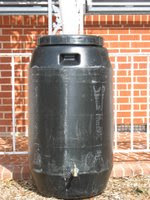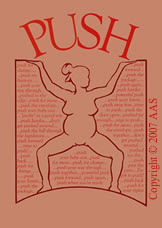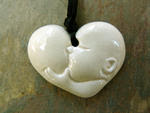This article is taken in it's entirety from www.Sazziesblog.blogspot.com ... also newly linked here. GREAT BLOG, Suzzie!
And, those Aussies --- oh, mama, they are so smart. THEY pay attention to the US reports and research, and they take appropriate action.
Positive Steps towards Medical Responsibility in Australian Reproductive Health
On April 7th the Australian Broadcasting Company (ABC) news reported that “The New South Wales Health Department has issued a new directive aimed at trying to reduce the number of unnecessary caesarean deliveries in state public hospitals.” The NSW government is moving towards implementing a policy that would ensure that caesareans will only be performed for medical reasons (ABC 07/04/07; ABC 09/04/07). Ultimately the policy is aimed at preventing wimmin from choosing caesareans as a preferred “method of birth” over vaginal birth.
This action comes seven months after an article in the New York Times publicised medical reports that elective caesareans are more likely to be fatal than vaginal births (Bakalar 2006, 05/09/07).
A member of the NSW Health Department, Andrew Child, suggests action needed to be taken by the government to ensure that women are fully aware of the risks associated with caesarean sections before undergoing the procedure (ABC, 07/04/07). He also suggested hospital staff’s attitudes towards caesarean need to change in order to make birth safer for Australian women (ABC, 07/04/07). He stated: “At the moment the staff are tending to just give it [caesarean section] a quick tick whereas this will enforce the need to make sure that all the risks and dangers are very clearly put on the table." (ABC, 07/04/07)
Western Australia’s (WA) health minister Mr Jim McGinty has also expressed support for the actions taken by NSW (ABC, 09/04/07). He said: "I think we should be doing everything we can to encourage natural child birth, that's best done by presenting women with a greater range of alternatives, alternatives to obstetric-led care.” (ABC, 09/04/07). The ABC report stated that McGinty acknowledges that there are too many caesareans occurring in the state of WA.
This is fantastic news for advocates of empowered birth such as myself. Effectively, Australian health authorities are acknowledging the high rates of caesarean, the massive health risk this poses to wimmin, and the need to challenge the current medicalised maternity system. McGinty’s comments, in particular, offer hope for the future for homebirth, and the potential for more evidence-based health care, to be adopted in Australia.
As I have stated previously, there are medical reasons that necessitate caesarean section, however these are rare, and the current rates of caesarean in Australia do not accurately reflect this (Sazz, 10/09/05; Sazz 11/09/06). Performing major abdominal surgery (which poses significant health risks - including fatality - to wimmin and their babies) only when it is absolutely medically necessary is common sense. The kind of common sense many birth advocates have been calling for, for years. The medical profession in Australia has acted irresponsibly with regard to birth and caesareans, giving wimmin the impression that caesarean is just another way to birth, and downplaying the significant risks they actually face in having the operation. The News South Wales Health Department, and Mr McGinty, indicate that finally medical professionals will be expected to act responsibly.
I am, however, concerned that this issue will be couched in terms of wimmin’s rights, or wimmin’s uneducated/unreasonable/unmedical demands. Previously the controversy over high rates of caesarean births in Australia have been painted as a matter of irresponsible wimmin, rather than irresponsible medicine (Sazz, 16/04/05). The misconception being that birthing wimmin are the one’s demanding caesareans against their doctors orders (as if the doctors are powerless!). Elective caesareans that are “elected” by wimmin themselves are in the minority (Sazz, 16/04/05). It is hospital staff and medical doctors who are the primary users of non-medical justifications for caesareans. Some of these justifications include: convenience, fear of litigation, and financial gain (Ruzek 1991; Goer 1995, 25; Wagner 2005). As I have written elsewhere:
Caesareans are a convenient option for obstetricians, as they can be scheduled in advance and the time it takes to perform the procedure is more predictable than natural birth. Studies have shown that as the number of births involving technological intervention increases so does the percentage of births that occur between the hours of nine to five (Eaton, 2005, 30).
The economic aspect of caesareans also plays a part in medical professional’s willingness to perform the surgery when it is not medically necessary. One obstetrician made this obvious when he stated:
I believe that the trend in obstetrics will continue toward managed labor because traditional care for the normal woman in labor is no longer cost-effective. It is no longer feasible for individual physicians who have invested 12 years in training at a cost of hundreds of thousands of dollars to dedicate extended periods to observing one normal woman in labor (in Eaton 2005, 30).
Considering that non-medical justifications for caesareans are most likely to be pushed by medical practitioners, it is important for government legislation to go beyond simply ensuring wimmin cannot choose to have a caesarean for non-medical reasons. The medical professional’s power to dictate what is deemed “medically necessary” remains of vital importance. So I celebrate these news reports, but with cautious optimism.
In addition to taking responsible action that will benefit wimmin and children in birth, the NSW and WA health authorities are taking steps towards bringing Australia into line with the recommendations of The World Health Organisation. The Fortelesa Declaration states that there is no justification for more than 10-15% caesarean births in any specific region (Birth Matters 2003, 16). How unfortunate that the national authorities, i.e. The Australian Medical Association, have been comparably silent and inactive on this issue.
Hopefully this push for medical responsibility in birth in NSW and WA will have a flow-on effect throughout Australia. And maybe we might finally live in a nation where surgery is only performed when medically necessary, not medically convenient.
Sources
ABC News, (07/04/07) “Doctors told to reduce caesarean births” http://www.abc.net.au/news/newsitems/200704/s1891907.htm
ABC News, (09/04/07), “McGinty delivers support for fewer caesareans”, http://www.abc.net.au/news/newsitems/200704/s1892470.htm
“Birth Is Not an Illness: The Fortelesa Declaration, WHO 1985,” (2003) Birth Matters, September: 16.
Bakalar, Nicholas, (05/09/07) “Voluntary C-Sections Result in More Baby Deaths”, New York Times, http://www.nytimes.com/2006/09/05/health/05birt.html
Eaton, Sarah (2005) “The Medical Model of Reproduction: a path to artificial wombs” New Antigone, 1, Spring & Summer: 28-38.http://www.newantigone.com/oscommercedownload/the%20medical%20model%20of%20reproduction.pdf
Goer, Hencie, (1995) Obstetric Myths Versus Research Realities: A Guide to the Medical Literature, Westport Connecticut London: Bergin and Gravey.
Ruzek, Sheryl, (1991) "Women's Reproductive Rights: the impact of technology," in Judith Rodin and Aila Collins eds Women and New Reproductive Technologies: Medical, Psychosocial, Legal, and Ethical Dilemmas, New Jersey, Hove and London: Lawrence Erlbaum Associates.
Sazz, (16/04/05) “Anti-pregnant Woman Sentiment in The Age”, Sazz’s Blog, http://sazziesblog.blogspot.com/2005/04/anti-pregnant-woman-sentiment-in-age.html
Sazz, (10/09/05) “Birth and Reproduction: whose business? –NCAD talk”, Sazz’s Blog, http://sazziesblog.blogspot.com/2005/09/ncad-talk.html
Sazz, (11/09/06) “National Caesarean Awareness Day 2006”, Sazz’s Blog,
http://sazziesblog.blogspot.com/2006/09/national-caesarean-awareness-day-2006.html
Wagner, Marsden, (2005) Technology in Birth: First Do No Harm 2000 , cited 13 July, available from http://www.midwiferytoday.com/articles/technologyinbirth.asp
For more on Caesareans
http://sazziesblog.blogspot.com/search/label/caesarean*Thanks to Meredith Nash at the Baby Bump Project blog for drawing my attention to the April 7 2007 news item concerning NSW!http://babybumpproject.blogspot.com/2007/04/new-elective-caesar-policy.html
The Other Side of the Glass
Part One was officially released June 2013 in digital distribution format.
To purchase to to www.theothersideoftheglass.com
If you were a donor and want to download your copy send an email to theothersideoftheglassfilm@gmail.com.
The trailer
Thursday, April 12, 2007
Subscribe to:
Post Comments (Atom)
"Soft is the heart of a child. Do not harden it."
A public awareness reminder that things that happen behind the scenes, out of our sight, aren't always as rosy as we might think them to be. Perhaps its a restaurant cook who accidentally drops your burger
on the floor before placing it on the bun and serving it to you. Here it's an overworked apathetic (pathetic) nurse giving my newborn daughter her first bath.
Please comment and rate this video, so as to insure that it is viewed as widely as possible, perhaps to prevent other such abuse. -- The mother who posted this YouTube. How NOT to wash a baby on YouTube
Are you going to try to tell me that "babies don't remember?" There is no difference to this baby's experience and the imprinting of her nervous system/brain and one that is held and cleaned by the mother or father either at the hospital or at home?
By the way, this is probably NOT the baby's first bath. The nurse is ungloved. Medical staff protocol is that they can't handle a baby ungloved until is has been bathed (scrubbed if you've seen it) because the baby is a BIO-HAZARD -- for them. Never mind that the bio-hazard IS the baby's first line of defense against hospital germs.
Missouri Senator Louden Speaks
Finally, A Birth Film for Fathers
Part One of the "The Other Side of the Glass: Finally, A Birth Film for and about Men" was released June, 2013.
Through presentation of the current research and stories of fathers, the routine use of interventions are questioned. How we protect and support the physiological need of the human newborn attachment sequence is the foundation for creating safe birth wherever birth happens.
Based on knowing that babies are sentient beings and the experience of birth is remembered in the body, mind, and soul, fathers are asked to research for themselves what is best for their partner and baby and to prepare to protect their baby.
The film is designed for midwives, doulas, and couples, particularly fathers to work with their caregivers. Doctors and nurses in the medical environment are asked to "be kind" to the laboring, birthing baby, and newborn. They are called to be accountable for doing what science has been so clear about for decades. The mother-baby relationship is core for life. Doctors and nurses and hospital caregivers and administrators are asked to create protocols that protect the mother-baby relationship.
Men are asked to join together to address the vagaries of the medical system that harm their partner, baby and self in the process of the most defining moments of their lives. Men are asked to begin to challenge the system BEFORE they even conceive babies as there is no way to be assured of being able to protect his loved ones once they are in the medical machine, the war zone, on the conveyor belt -- some of the ways that men describe their journey into fatherhood in the medicine culture.
Donors can email theothersideoftheglassfilm@gmail.com to get a digital copy.
Through presentation of the current research and stories of fathers, the routine use of interventions are questioned. How we protect and support the physiological need of the human newborn attachment sequence is the foundation for creating safe birth wherever birth happens.
Based on knowing that babies are sentient beings and the experience of birth is remembered in the body, mind, and soul, fathers are asked to research for themselves what is best for their partner and baby and to prepare to protect their baby.
The film is designed for midwives, doulas, and couples, particularly fathers to work with their caregivers. Doctors and nurses in the medical environment are asked to "be kind" to the laboring, birthing baby, and newborn. They are called to be accountable for doing what science has been so clear about for decades. The mother-baby relationship is core for life. Doctors and nurses and hospital caregivers and administrators are asked to create protocols that protect the mother-baby relationship.
Men are asked to join together to address the vagaries of the medical system that harm their partner, baby and self in the process of the most defining moments of their lives. Men are asked to begin to challenge the system BEFORE they even conceive babies as there is no way to be assured of being able to protect his loved ones once they are in the medical machine, the war zone, on the conveyor belt -- some of the ways that men describe their journey into fatherhood in the medicine culture.
Donors can email theothersideoftheglassfilm@gmail.com to get a digital copy.
Buy the film at www.theothersideoftheglass.com.
The film focuses on the male baby, his journey from the womb to the world and reveals healing and integrating the mother, father, and baby's wounded birth experience. The film is about the restoring of our families, society, and world through birthing loved, protected, and nurtured males (and females, of course). It's about empowering males to support the females to birth humanity safely, lovingly, and consciously.
Finally, a birth film for fathers.
The film focuses on the male baby, his journey from the womb to the world and reveals healing and integrating the mother, father, and baby's wounded birth experience. The film is about the restoring of our families, society, and world through birthing loved, protected, and nurtured males (and females, of course). It's about empowering males to support the females to birth humanity safely, lovingly, and consciously.
Finally, a birth film for fathers.
What People Are Saying About the FIlm
Well, I finally had a chance to check out the trailer and .. wow! It's nice that they're acknowledging the father has more than just cursory rights (of course mom's rights are rarely acknowledged either) and it's great that they're bringing out the impact of the experience on the newborn, but I'm really impressed that they're not shying away from the political side.
They are rightly calling what happens in every American maternity unit, every day, by its rightful name - abuse. Abuse of the newborn, abuse of the parents and their rights, abuse of the supposedly sacrosanct ethical principal of patient autonomy and the medico-legal doctrine of informed consent, which has been long ago discarded in all but name. I love it!
In the immortal words of the "shrub", "bring it on!" This film needs to be shown and if I can help facilitate or promote it, let me know.
Father in Asheville, NC
Thanks for sharing this. It was very touching to me. I thought of my brother-in-law standing on the other side of the glass when my sister had to have a C-section with her first child because the doctor was missing his golf date. I'll never forget his pacing back and forth and my realizing that he was already a father, even though he hadn't been allowed to be with his son yet.
Margaret, Columbia, MO
They are rightly calling what happens in every American maternity unit, every day, by its rightful name - abuse. Abuse of the newborn, abuse of the parents and their rights, abuse of the supposedly sacrosanct ethical principal of patient autonomy and the medico-legal doctrine of informed consent, which has been long ago discarded in all but name. I love it!
In the immortal words of the "shrub", "bring it on!" This film needs to be shown and if I can help facilitate or promote it, let me know.
Father in Asheville, NC
OMG'ess, I just saw the trailer and am in tears. This is so needed. I watch over and over and over as fathers get swallowed in the fear of hospitals birth practice. I need a tool like this to help fathers see how very vital it is for them to protect their partner and baby. I am torn apart every time I see a father stand back and chew his knuckle while his wife is essentially assaulted or his baby is left to lie there screaming.
Please send me more info!!!!
Carrie Hankins
CD(DONA), CCCE, Aspiring Midwife
720-936-3609
Thanks for sharing this. It was very touching to me. I thought of my brother-in-law standing on the other side of the glass when my sister had to have a C-section with her first child because the doctor was missing his golf date. I'll never forget his pacing back and forth and my realizing that he was already a father, even though he hadn't been allowed to be with his son yet.
Margaret, Columbia, MO
In case you don't find me here
Soon, I'll be back to heavy-duty editing and it will be quiet here again. I keep thinking this blog is winding down, and then it revives. It is so important to me.
I wish I'd kept a blog of my journey with this film this past 10 months. It's been amazing.
I have a new blog address for the film, and will keep a journal of simple reporting of the journey for the rest of the film.
www.theothersideoftheglassthefilm.blogspot.com
I'll be heading east this week to meet with a group of men. I plan to post pictures and clips on the film blog.
I'll keep up here when I can -- when I learn something juicy, outrageous, or inspiring related to making birth safer for the birthing baby.
I wish I'd kept a blog of my journey with this film this past 10 months. It's been amazing.
I have a new blog address for the film, and will keep a journal of simple reporting of the journey for the rest of the film.
www.theothersideoftheglassthefilm.blogspot.com
I'll be heading east this week to meet with a group of men. I plan to post pictures and clips on the film blog.
I'll keep up here when I can -- when I learn something juicy, outrageous, or inspiring related to making birth safer for the birthing baby.
Review of the film
Most of us were born surrounded by people who had no clue about how aware and feeling we were. This trailer triggers a lot of emotions for people if they have not considered the baby's needs and were not considered as a baby. Most of us born in the US were not. The final film will include detailed and profound information about the science-based, cutting-edge therapies for healing birth trauma.
The full film will have the interviews of a wider spectrum of professionals and fathers, and will include a third birth, at home, where the caregivers do a necessary intervention, suctioning, while being conscious of the baby.
The final version will feature OBs, RNs, CNMs, LM, CPM, Doulas, childbirth educators, pre and perinatal psychologists and trauma healing therapists, physiologists, neurologists, speech therapists and lots and lots of fathers -- will hopefully be done in early 2009.
The final version will include the science needed to advocated for delayed cord clamping, and the science that shows when a baby needs to be suctioned and addresses other interventions. Experts in conscious parenting will teach how to be present with a sentient newborn in a conscious, gentle way -- especially when administering life-saving techniques.
The goal is to keep the baby in the mother's arms so that the baby gets all of his or her placental blood and to avoid unnecessary, violating, and abusive touch and interactions. When we do that, whether at home or hospital, with doctor or midwife, the birth is safe for the father. The "trick" for birthing men and women is how to make it happen in the hospital.
The full film will have the interviews of a wider spectrum of professionals and fathers, and will include a third birth, at home, where the caregivers do a necessary intervention, suctioning, while being conscious of the baby.
The final version will feature OBs, RNs, CNMs, LM, CPM, Doulas, childbirth educators, pre and perinatal psychologists and trauma healing therapists, physiologists, neurologists, speech therapists and lots and lots of fathers -- will hopefully be done in early 2009.
The final version will include the science needed to advocated for delayed cord clamping, and the science that shows when a baby needs to be suctioned and addresses other interventions. Experts in conscious parenting will teach how to be present with a sentient newborn in a conscious, gentle way -- especially when administering life-saving techniques.
The goal is to keep the baby in the mother's arms so that the baby gets all of his or her placental blood and to avoid unnecessary, violating, and abusive touch and interactions. When we do that, whether at home or hospital, with doctor or midwife, the birth is safe for the father. The "trick" for birthing men and women is how to make it happen in the hospital.








2 comments:
Thanks for including my blog entry here, Miranda!
Don't know that I agree with you on the intelligence of Aussies though :) For one, our medical association continues to promote the old fashioned notion that the medical model is the best model for birth, despite the numerous studies attesting to the safety of homebirth, not to mention the plethora of wimmin's voices for homebirth and against hospital birth - many of whom have experienced both! I wonder how long it will be before these big medical associations will count wimmin's personal testimonies, feelings, and experiences of birth as part of what constitutes an "outcome"?
I thought you might be interested in this blog entry too. I interviewed the founder of Joyous Birth, and I think she summarises (that's Aussie for "summarizes" ;) )a lot of the problems with the current model of birth in Australia:
http://sazziesblog.blogspot.com/2006/07/joyous-birth-one-example-of-grassroots.html
Thank You for posting t hat blog entry and links- It's nice to see some positive steps being taken!!
Post a Comment